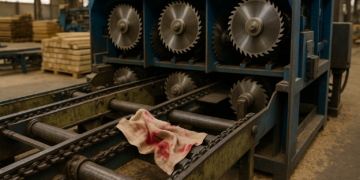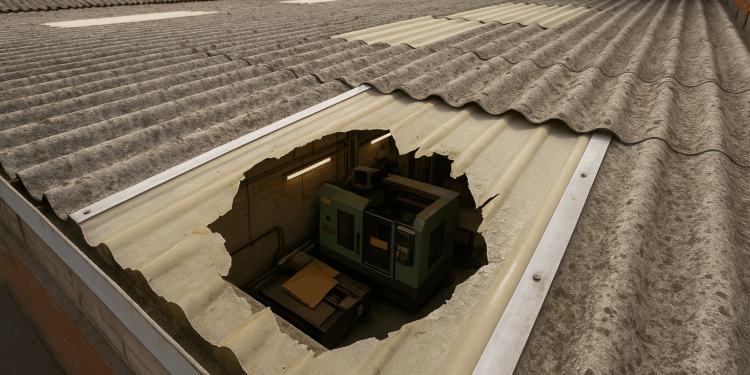Story Highlight
– Worker fell through fragile rooflight, sustaining injuries.
– A.T. Lee Properties and LJH Property pleaded guilty.
– Companies lacked safety measures for roof work.
– Fines imposed at Leeds Magistrates’ Court.
– Incident highlights risks of unplanned roof work.
Full Story
In a distressing incident that unfolded in Glusburn, Keighley, on July 8, 2022, several workers faced severe hazards due to inadequate safety protocols implemented by local firms A.T. Lee Properties and LJH Property. The situation escalated when one of the workers fell through a fragile rooflight, resulting in a dramatic injury as he landed on machinery below, narrowly escaping a more severe accident involving a nearby machine operator.
During the incident, the injured worker was on the roof alongside two colleagues, engaged in the task of over-cladding an existing asbestos cement surface. Unfortunately, as he shifted his weight and inadvertently stepped onto the brittle rooflight, he fell through the structure, leading to a complicated rescue operation.
Emergency services, including firefighters, quickly responded to the scene, successfully extricating the individual from the precarious situation. Remarkably, he sustained only “relatively minor injuries” despite the “horrific circumstances,” an assessment provided by a spokesperson from the Health and Safety Executive (HSE), the agency that conducted a subsequent investigation into the incident.
The investigation revealed that A.T. Lee Properties, designated as the principal contractor for work at the Cirteq Ltd site located in Hayfield Mills on Colne Road, had significantly neglected their responsibilities. They failed to develop adequate plans to ensure safe working conditions and did not implement necessary preventative measures to mitigate risks associated with roofing work. Furthermore, both A.T. Lee and their subcontractor, LJH Property, did not provide the appropriate tools or equipment essential for the safe execution of the task at hand.
LJH Property, which bore responsibility for the planning and supervision of the work, was also found lacking, having not trained or equipped their workers suitably. Their risk assessment was deemed ineffective and inappropriate, leaving workers exposed to dangerous situations without adequate oversight.
On October 1 of this year, the case was brought before Leeds Magistrates’ Court, where both companies, along with company director Neil Cryer of A.T. Lee Properties and owner Luke Hudson of LJH Property, pleaded guilty to violations of the Health and Safety at Work Act. As a consequence of their failings, Hudson’s firm was fined £47,818 and ordered to pay an additional £2,518 in costs. A.T. Lee Properties received a slightly lower penalty of £47,783 and was directed to pay £2,386 in costs.
In court, both Cryer and Hudson were given two-year conditional discharges and were ordered to cover £2,369 each for court costs. The HSE’s principal inspector Paul Thompson, who spearheaded the investigation, expressed grave concerns regarding the incident. “People working on the roof and those working below within the factory were placed at serious risk,” he said, highlighting the negligence exhibited by the contractors involved.
Thompson emphasized the serious implications of the incident, noting that “this could have been a wholly different outcome” had the worker fallen even slightly away from the point of impact. He cautioned that falls from height remain the predominant cause of workplace fatalities, urging that effective planning, management, and monitoring are critical in preventing such incidents in the future.
The ramifications of this incident serve as a stark reminder of the vital importance of adherence to health and safety regulations in the construction industry. Both companies involved in this case have been urged to review and rectify their safety protocols to ensure that the welfare of their employees and subcontractors is prioritized moving forward.






















This incident is a clear reminder that basic risk assessment and proper training must never be overlooked. Fragile rooflights are a known hazard and working on roofs requires planning, suitable edge protection or safe access systems and clear instructions to keep people safe. Employers must make sure all roof work is identified in advance, workers are briefed on the risks and given the correct equipment and supervision. Cutting corners on safety not only harms people but also carries serious legal and financial consequences.
This incident highlights a clear failure to assess risks and put in place basic protective measures before work at height. All employers must ensure roof hazards are identified, fragile materials are treated as such, and workers receive practical training and equipment for safe access and edge protection. Fines are justified but preventing harm requires proactive planning supervision and a safety culture that empowers workers to stop unsafe work.